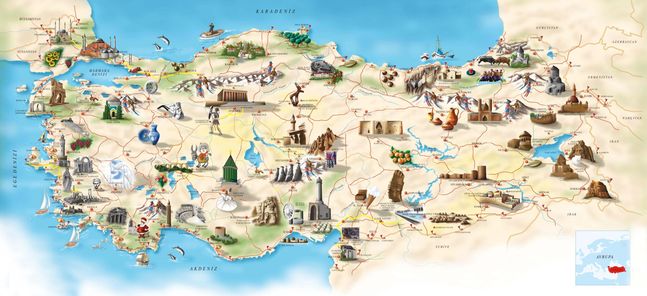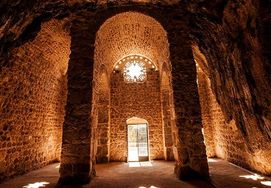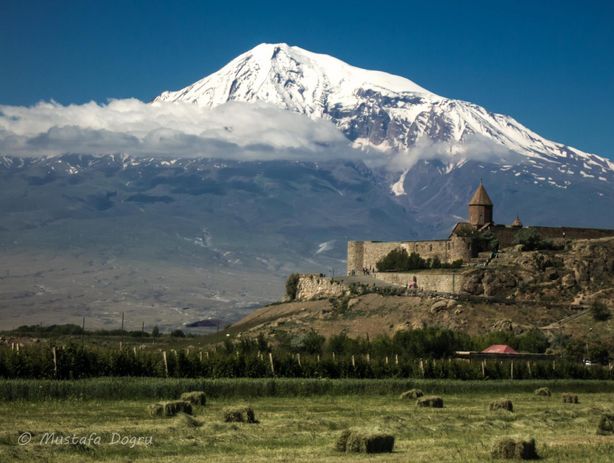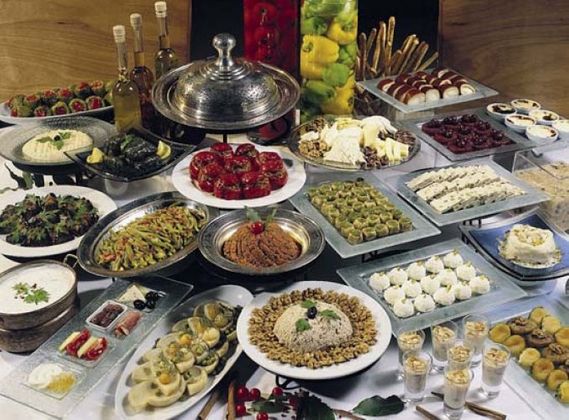Turkey travel guide
Turkey is currently the world’s 6th most popular holiday destination with 51.9 million visitors last year alone. Also, two Turkish cities, Istanbul and Antalya, are among the top 10 most visited cities in the world – Istanbul received more foreign visitors than New York City last year.
What makes Turkey a unique destination is the incredible richness and wide range of her offerings, from a 12,000-year-old diverse history and a beautiful natural landscape to a top-notch cuisine and warm hospitality of her people.
“Turkey is the world’s sixth most popular travel destination with a 12,000-year-old history, an incredibly rich cuisine and idyllic beaches”
Cradle of Civilizations

 But it is not only the Islamic, Byzantine, and Roman cultures you indulge yourself into in this country. You can also trace the history of Christianity and the first Christians from Abraham to Apostle John and the Virgin Mary. Imagine a country where the first Christian church was founded and the disciples of Jesus Christ were first called Christians. Again, imagine a country where St. Nicholas (also known as Santa Claus), St. John, St. Paul, and St. Peter lived and prayed and the Virgin Mary spent her last days. Consequently, all these religious sites and others make Turkey a premier destination for faith tourism as well.
But it is not only the Islamic, Byzantine, and Roman cultures you indulge yourself into in this country. You can also trace the history of Christianity and the first Christians from Abraham to Apostle John and the Virgin Mary. Imagine a country where the first Christian church was founded and the disciples of Jesus Christ were first called Christians. Again, imagine a country where St. Nicholas (also known as Santa Claus), St. John, St. Paul, and St. Peter lived and prayed and the Virgin Mary spent her last days. Consequently, all these religious sites and others make Turkey a premier destination for faith tourism as well.Today, it is almost impossible to not have goosebumps while exploring the ever-living traces of all these rich civilizations in Turkey – a country that resembles more of an open-air museum with her well-preserved historical sites and culture.
East meets West
Turkey is a bridge between East and West both geographically and culturally. And this is why today’s Turkish culture is a unique blend of modern and old, and East and West with its rich and diverse history. This unique feel is apparent anywhere in the country. The more east one travels, the more eastern and exotic it gradually starts feeling.
Who are the Turks?
Today’s Turks are the mix of the descendants of the Turkic nomads from Central Asia with the refugees from Eastern Europe, the Balkans, Crimea, and the Caucasus during the fall of the Ottoman Empire as well as with the early peoples of Anatolia (Asia Minor). In other words, they are the microcosm of the Muslim population of the Ottoman Empire except for the Arabs and the Kurds.
Turkic tribes, who were nomads in Central Asian plains, continuously settled in Anatolia in small groups and mingled with local inhabitants during the last 10,000+ years. Many local inhabitants of Anatolia converted to Islam through their interaction with Turkic people and adopted the Turkish language and the culture.
The Ottoman Empire, known for its religious tolerance, had no concept of race and didn’t exclude anyone during its 623-year reign. When the empire’s territories started shrinking in the 19th and 20th centuries, many of its Muslim subjects in Eastern Europe, the Balkans, Crimea, and the Caucasus fled to Anatolia and Eastern Thrace as refugees. Many of these Ottoman subjects were neither ethnically Turkish nor could they speak the language. The Turkish Republic, from 1923 on, became the melting pot for all these ethnically diverse adopted Turks, including but not limited to Albanians, Bosnians, Bulgarians, Greeks, Romanians, Circassians, Georgians, Abkhazians, and Laz. It is worth noting that close to 50% of the population were foreign-born refugees during the proclamation of the republic in 1923.
“Giving to a stranger at one’s doorstep as if giving to God forms the basis of the Turkish hospitality”
After all this, it is misleading to limit Turks’ identity and culture to a single area or ethnicity. Turks wear many hats and this is one of the major factors that differentiate them from any other country in Europe and the Middle East. You can see this richness in every aspect of the culture, including the Turkish cuisine, which is considered to be one of the three most prominent cuisines of the world.
Turkish hospitality
Of course, a crucial component of a country is its people. Turkish culture and religion dictate going out of one’s way to give others as much as possible and accordingly, giving to a stranger at one’s doorstep as if giving to God forms the basis of the famous Turkish hospitality. Turks believe that the more generous a person is, the more he or she will be given and blessed by God. As a result, being generous to others is strongly encouraged by Turkish society from childhood years on. Furthermore, inviting guests to their house for a meal and being generous to them is an important part of the Turkish family culture.
Turkish cuisine
Turkish cuisine is regarded as one of the top three most prominent cuisines in the world, along with the French and the Chinese cuisines. Its main characteristics are rich flavors, fresh ingredients, and incredible diversity. Frankly, it is one of the best things about visiting Turkey. Both meat lovers and vegetarians can find a wide range of food options with rich flavors to satisfy their taste buds while in the country.
Turkish cuisine typically uses rich and fresh ingredients and has incredible variety. In contrast to Chinese cuisine, dishes are cooked slowly in low heat. As a result, flavors can blend together better and become richer. Olive oil is widely used.
“Today’s Turkish culture is an amalgam of the cultures of the Balkans, Anatolia (Asia Minor) and the Caucasus”
A country’s cuisine is a good reflection of the richness and the diversity of its culture and history. Accordingly, one can see the traces of its long and diverse history in the Turkish culinary culture. The start of the Turkish culinary culture dates back to the Turkic nomadic tribes of Central Asia. They brought their culinary culture to Anatolia (Asia Minor) and their interactions with local peoples in their new homelands helped them create a richer and more diverse culinary culture. As a result, Turkish cuisine became a good representation of the culinary cultural mix of Central Asia and the 20 different civilizations that lived and prospered in today’s Turkey within the last 12,000 years. It also represents the cultural diversity of the former Ottoman territories.
Turkish cuisine is the continuation of the Ottoman cuisine, which had a long imperial tradition. The Ottoman palace cuisine played a central role in the formation of the Ottoman cuisine. There were about 1,300 people working in the Ottoman palace kitchen serving 5,000-15,000 people daily. The chefs in the imperial palace not only experimented with different ingredients, but they also helped form a unified Ottoman culinary culture by combining the diverse food traditions within the empire. Consequently, this unified culinary culture shaped local cuisines of the many Ottoman territories, including the Balkans, the Caucasus, and the Middle East, where it still continues to exist today.
Turkish language
The Turkish language has more than 90 million speakers in Turkey, Europe, and Northern Cyprus. It is part of the Turkic language family that consists of 35 different languages with more than 200 million speakers. Turkic speakers live in a wide geographical area spanning from Eastern Europe all the way to China and most Turkic languages are mutually intelligible with Turkish. Thus, learning Turkish is a good starting point to learn any other Turkic language.
Even though they don’t belong to the Turkic language family, the closest languages to Turkish in Europe are Hungarian and Finnish. However, neither of these three languages is mutually intelligible.
Turkish is an agglutinative language and thus, it has a different grammar structure than most other languages. Despite this difference, Turkish is not difficult to learn, because it is formulaic and extremely logical. Besides being regular – which means it has very few exceptions – it is phonetic and it uses the Latin alphabet.
The Turkish language has lately become increasingly more popular around the world for various reasons. These reasons include, but are not limited to Turkey’s increasing importance on the world stage both as a geopolitical powerhouse and a popular global destination for travel and retirement as well as the huge success of the Turkish TV dramas all around the world.
“Turkish cuisine is regarded as one of the top three most prominent cuisines of the world in terms of richness and flavor”
Natural landscape

From the temperate and lush Black Sea coast, protected by high mountain ranges, to the most pristine beaches of the Mediterranean – the word turquoise is the French word depicting the color of the Turkish Mediterranean – and from the rugged and snow-capped mountains of the East, where winters are cold and long, to the fertile valleys and the lace-like shores of the Aegean, Turkey offers a wide range of alternative landscapes.
Here is a short video depicting the idyllic Turkish beaches:
Anatolia (Asia Minor) is encircled by mountains that offer an exceptional variety of wildlife, flora, and fauna. The three highest peaks of Turkey are Mt. Ararat (5137 meters/16,853 feet), where Noah’s Ark is believed to have landed, Mt. Kackar (3932 meters/12,900 feet), and Mt. Erciyes (3917 meters/12,851 feet) in Eastern and Central Turkey.

When to go
Turkey has four seasons and summer (June – August) is the high season. However, generally speaking, late April and all May in the spring and September and early October in the fall are the best times to visit Turkey. The prices are lower and it doesn’t get as hot and crowded.
How to get around
There are various transportation options depending on your budget and taste.
AIRPLANE: Flying is cheap in Turkey and Pegasus Airlines offers a more affordable alternative to Turkey’s national carrier Turkish Airlines.
BUS: Turkey has the best and most effective bus system you may have ever seen. Night intercity buses offer a comfortable alternative to plane.
TRAIN: Railway network is rather limited in Turkey, although some cities including Istanbul, Ankara, Eskisehir, and Konya are interconnected with fast train, which is quick and comfortable.
CAR: For more flexibility, renting a car would also be a viable option, although gas is not very cheap. Turkish cities are interconnected with a very good highway system.
Safety
Turkey is a very safe country, however you still have to use common sense, same as in any safe country, and beware of pickpockets and con-artists, especially in tourist spots. This is very unlikely, but if you ever feel threatened or harassed by anyone, be assertive and don’t hesitate to raise your voice. Locals will always be on your side and come to your help, as you will be considered a guest in Turkey.
Alternative Turkey travel itineraries
Turkey offers a wide variety of choices for every traveler. Depending on how much time you have, you can either focus on a single region or explore several regions. The minimum recommended time for a quick tour of the country highlights is two weeks. However, this would still not be enough to see the complete picture, as each region of Turkey offers something unique.
Most people typically start in Istanbul and make a circle in western Turkey visiting Ephesus, Pamukkale, and one or two coastal towns on the Mediterranean or the Aegean coastline with a stop in Cappadocia in central Turkey. However, an ideal itinerary should also include places like Konya and Çatalhöyük in central Turkey, Urfa, Göbeklitepe, Mardin and Mt. Nemrut in eastern Turkey as well as the Black Sea coastline between Rize and Ordu, and Mt. Kaçkar in northeastern Turkey. Such a comprehensive travel itinerary would require at least a month but would promise unique experiences with locals and a great opportunity to learn about the local culture in return.
Istanbul, not Constantinople!

A Turkey page wouldn’t be complete without at least a paragraph on Istanbul. It was the capital of three great empires: the Roman, Byzantium, and the Ottoman Empires. Napoleon Bonaparte once said, “If only one state existed on earth, Istanbul would be the capital”.
Considered a holy city for both Islam and Orthodox Christianity, Istanbul has 157 Christian churches, 17 synagogues, 10 monasteries, and close to 2,000 mosques.
“Napoleon Bonaparte: If the earth were a single state, Istanbul would be its capital”
Istanbul is the only city in the world that lies on two continents: half of the city is in Europe and the other half is in Asia. Walking through the streets of Istanbul, you will have moments where you will feel like you are in any western metropolis. Then you will turn your head and travel a few centuries back in time. In Istanbul, you will feel the West but sense the East. The magical history of the last couple of thousand years will be all around you, blending into a modern city.


